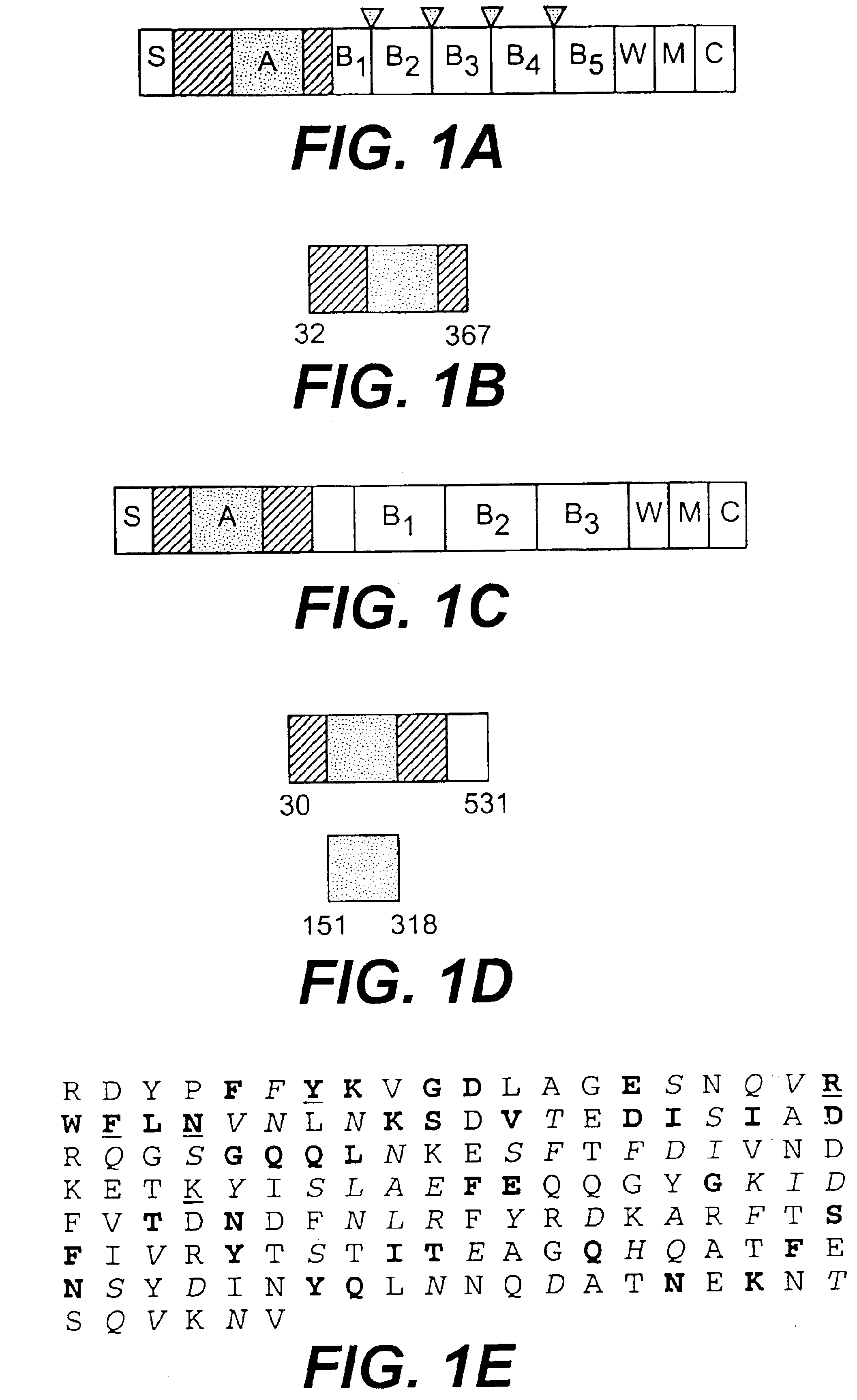Collagen-binding proteins from enterococcal bacteria
a technology of enterococcal bacteria and collagen, which is applied in the field of collagen-binding proteins from enterococcal bacteria, can solve the problems of limited knowledge of the molecular pathogenesis of enterococcal infections, and the health care providers may be left without any effective means to treat serious infections caused, and achieve the effect of inhibiting adhesion
- Summary
- Abstract
- Description
- Claims
- Application Information
AI Technical Summary
Benefits of technology
Problems solved by technology
Method used
Image
Examples
example 1
NUMBERED REFERENCES TO SPECIFICATION AND EXAMPLE 1
[0200]1. Murray, B. E. (1990) Clin. Microbiol. Rev. 3, 46-65[0201]2. Foster, T. J. and Höök, M. (1998) Trends Microbiol. 6, 484-488[0202]3. Patti, J. M., Allen, B. L., McGavin, M. J., and Höök, M. (1994) Annu. Rev. Microbiol. 48, 585-617[0203]4. Patti, J. M., Jonsson, H., Guss, B., Switalski, L. M., Wiberg, K., Lindberg, M., and Höök, M. (1992) J. Biol. Chem. 267, 4766-4772[0204]5. Patti, J. M., Boles, J. O., and Höök, M. (1993) Biochem. 32, 11428-11435[0205]6. Nilsson, I. -M., Patti, J. M., Bremell, T., Höök, M., and Tarkowski, A. (1998) J. Clin. Invest. 101, 2640-2649[0206]7. Symersky, J., Patti, J. M., Carson, M., House-Pompeo, K., Teale, M., Moore, D., Jin, L., DeLucas, L. J., Höök, M., and Narayana, S. V. L. (1997) Nat. Struct. Biol. 10, 833-838[0207]8. Rich, R. L., Demeler, B., Ashby, K., Deivanayagarn, C. C. S., Petrich, J. W., Patti, J. M., Narayana, S. V. L., and Höök, M. (1998) Biochemistry 37, 15423-15433[0208]9. Gillaspy,...
example 2
REFERENCES TO EXAMPLE 2
[0229]1. Beck, K., I. Hunter, and J. Engel. 1990. Structure and function of laminin: anatomy of a multidomain glycoprotein. FASEB J. 4:148-160.[0230]2. Duh, R. W., K. V. Singh, K. Malathum, and B. E. Murray. Comparision of in vitro activity of 19 antimicrobial agents against enterococci from healthy subjects and hospitalized patients. Microbial Drurg Resistance (Submitted for publication).[0231]3. Engel, J. 1992. Laminins and other strange proteins. Biochemistry. 31:10643-10651.[0232]4. Ettner, N., W. Göhring, T. Sasaki, K. Mann, and R. Timpl. 1998. The N-terminal globular domain of the laminin α1 chain binds to α1β1 and α2β1 integrins and to the heparan sulfate-containing domains of perlecan. FEBS Lett. 430:217-221.[0233]5. Flügel, A., H. Schulze-Koops, J. Heesemann, K. Kühn, L. Sorokin, H. Burkhardt, K. von der Mark, and F. Emmrich. 1994. Interaction of enteropathogenic Yersinia enterocolitica with complex basement membranes and the extracellular matrix prot...
example 3
REFERENCES TO EXAMPLE 3
PUM
| Property | Measurement | Unit |
|---|---|---|
| Length | aaaaa | aaaaa |
| Adhesion strength | aaaaa | aaaaa |
Abstract
Description
Claims
Application Information
 Login to View More
Login to View More - R&D
- Intellectual Property
- Life Sciences
- Materials
- Tech Scout
- Unparalleled Data Quality
- Higher Quality Content
- 60% Fewer Hallucinations
Browse by: Latest US Patents, China's latest patents, Technical Efficacy Thesaurus, Application Domain, Technology Topic, Popular Technical Reports.
© 2025 PatSnap. All rights reserved.Legal|Privacy policy|Modern Slavery Act Transparency Statement|Sitemap|About US| Contact US: help@patsnap.com



